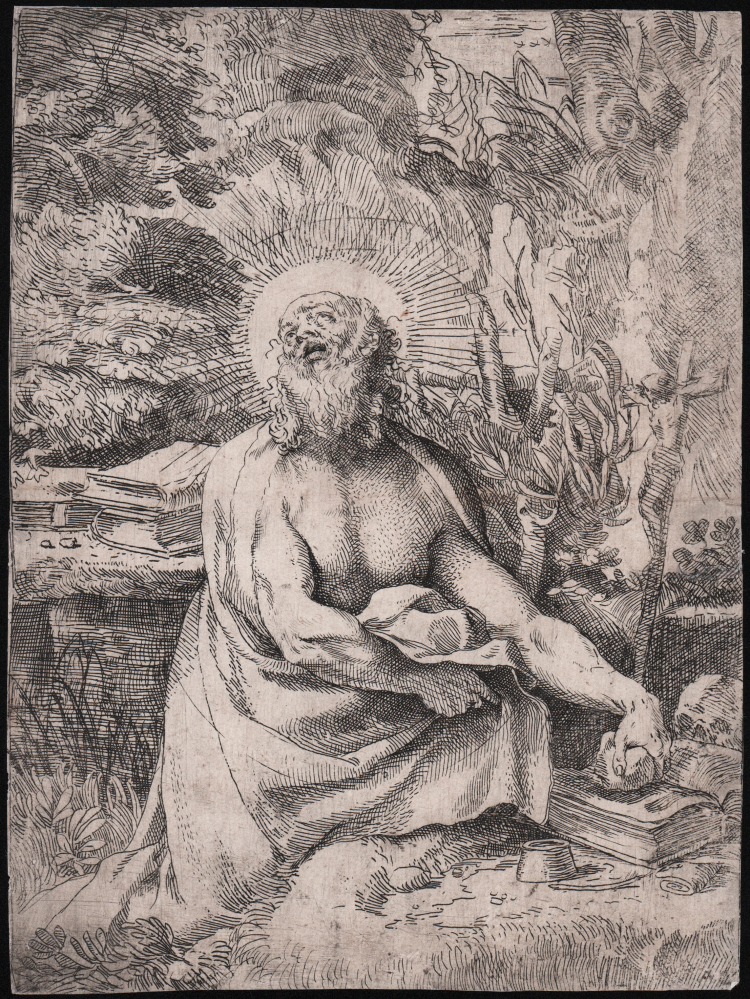




| Reference: | S47064 |
| Author | Annibale CARRACCI |
| Year: | 1591 |
| Measures: | 190 x 255 mm |



| Reference: | S47064 |
| Author | Annibale CARRACCI |
| Year: | 1591 |
| Measures: | 190 x 255 mm |
St Jerome in the wilderness; the saint kneeling in centre looking upat heaven, holding his robe with his right hand and a stone in the left hand, with books, a skull and crucifix next to him.
Etching and engraving, circa 1591. Example of the first state, before the Pietro Stefanoni address.
A good impression, printed on contemporary laid paper, trimmed to the borderline, traces of glue and minimal restoration visible on verso, otherwise in good condition.
“Saint Jerome is shown here not simply as a penitent brooding in the wilderness, but as a holy figure at a moment of spiritual ecstasy, in communion with his God, as seen in such works as Caravaggio's The Conversion of Saul, Bernini's Vision of Saint Theresa, and Ribera's Saint Jerome, to cite only the most cogent examples. Like Caravaggio, Bernini, and Ribera, Annibale took pains to convince the viewer of the reality of the miracle - that God can appear to mortal men on earth, and that divine possession is plausible as a purely personal phenomenon taking place within an individual in a down-to-earth setting. To that end, Saint Jerome is solid, robust, and realistically rendered. Like a great boulder, he seems to be part of the wilderness that surrounds him.
Annibale's technique here - mostly etching with some engraving - is admirably suited to the expressive concerns of the print. His heavy, firm, and deliberate etched strokes and dense, weighty hatchings suit the sober massiveness of the composition. The relatively undifferentiated weight of etched lines in both the figure and the setting helps to weave Saint Jerome into the wilderness of trees, rocks, and foliage. The face and beard, in contrast, are defined by lighter, sketchier lines, suggesting that their material substance has been dissolved by the divine light that pulses in the saint's halo” (cf. Richard Wallace in Italian Etchers of the Reinassance & Barocque, pp. 108-109).
Bibliografia
Bartsch, Le Peintre graveur (XVIII.190.14); Bohlin 1979, Prints and related drawings by the Carracci family (13.I); Posner 1971; Annibale Carracci, a study in the reform of Italian painting around 1590 (64); Welsh & Reed, Italian Etchers of the Reinassance & Barocque, pp. 108-109, n. 51.
Annibale CARRACCI (Bologna 1560 - Roma 1609)
|
Younger brother of Agostino and cousin of Ludovico, who was also his teacher, Annibale is the leading figure of the XVII century school of Bologna and among the greatest artist of Italian Classicism.
The initial stage of his art was still very close to late Mannerism, tightly connected with Campi’s style. He then came to maturity, under an artistic point of view, drawing inspiration from the greatest artists of Italian Renaissance and he expressed the climax of his career in the frescoes inside Palazzo Farnese (1595-1604) in Rome, which are considered the highest example of Italian Classicism.
Following Agostino, he started to study engraving and etching; we can ascribe to him 17 prints, mainly with religious subjects. Just two of them bear a mythological subject in which it can be found once again the Alexandrine spirit of the mythological tale.
|
Annibale CARRACCI (Bologna 1560 - Roma 1609)
|
Younger brother of Agostino and cousin of Ludovico, who was also his teacher, Annibale is the leading figure of the XVII century school of Bologna and among the greatest artist of Italian Classicism.
The initial stage of his art was still very close to late Mannerism, tightly connected with Campi’s style. He then came to maturity, under an artistic point of view, drawing inspiration from the greatest artists of Italian Renaissance and he expressed the climax of his career in the frescoes inside Palazzo Farnese (1595-1604) in Rome, which are considered the highest example of Italian Classicism.
Following Agostino, he started to study engraving and etching; we can ascribe to him 17 prints, mainly with religious subjects. Just two of them bear a mythological subject in which it can be found once again the Alexandrine spirit of the mythological tale.
|